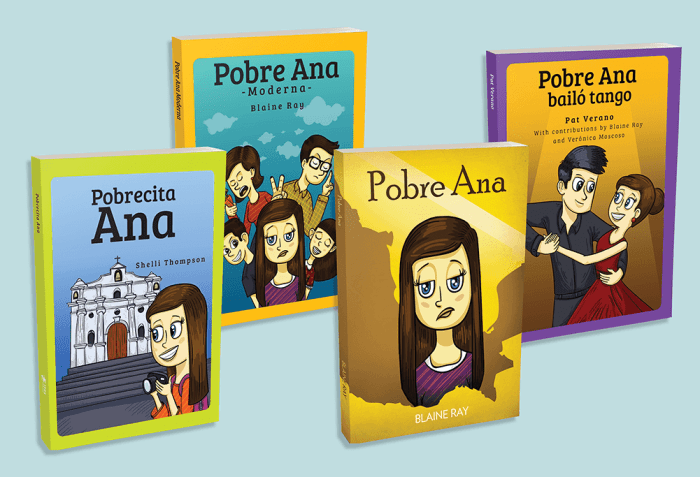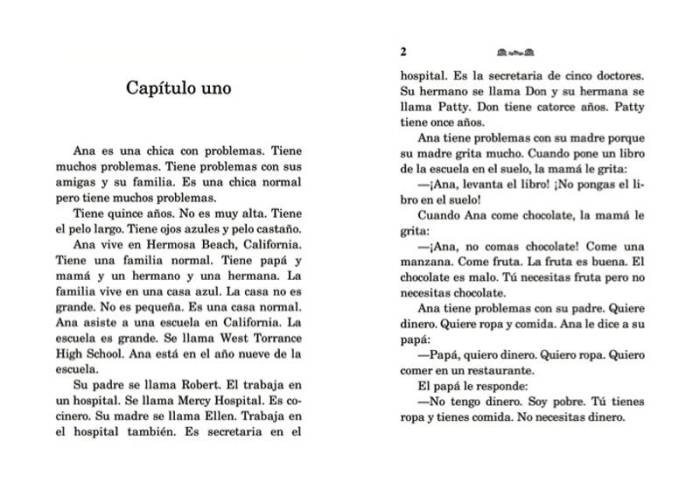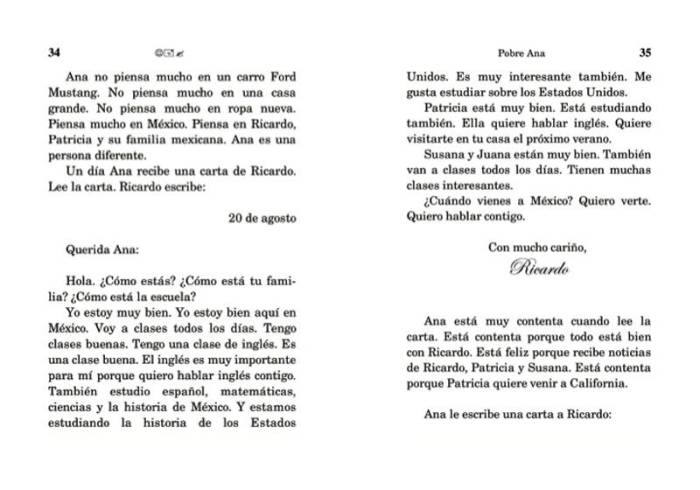Pobre ana in english pdf – Unveiling the captivating melody and poignant lyrics of “Pobre Ana” in English PDF, this comprehensive guide delves into the historical, lyrical, and cultural significance of this beloved Spanish ballad.
Prepare to be captivated as we embark on a journey through the origins, themes, and enduring legacy of “Pobre Ana,” a song that has touched the hearts of generations.
Historical Context of “Pobre Ana”

The origins of “Pobre Ana” are shrouded in mystery, with several theories about its composer and the time period of its creation. One widely held belief attributes the song to a Spanish composer named Manuel Penella Moreno, who lived from 1847 to 1909. Penella Moreno was known for his contributions to the zarzuela, a form of Spanish musical theater, and it is speculated that “Pobre Ana” may have originated as a zarzuela song.
Another theory suggests that the song emerged in the late 19th or early 20th century as a folk song, passed down orally through generations. This theory is supported by the fact that the song has been recorded by numerous artists across Latin America and Spain, with slight variations in lyrics and melody.
Cultural Impact, Pobre ana in english pdf
Regardless of its exact origins, “Pobre Ana” has become an enduring classic in Spanish-speaking cultures. Its popularity can be attributed to its relatable themes of love, loss, and heartbreak, which resonate with audiences of all ages. The song’s simple yet poignant lyrics and haunting melody have made it a favorite among singers and musicians, and it has been featured in films, television shows, and stage productions.
Lyrical Analysis of “Pobre Ana”

The lyrics of “Pobre Ana” paint a vivid portrait of a woman who has endured unimaginable suffering and loss. The song’s main themes include poverty, injustice, and the resilience of the human spirit. The lyrics are rich in symbolism, using metaphors and similes to convey the depth of Ana’s pain and the challenges she faces.
Poverty and Injustice
The song’s opening lines establish Ana’s desperate situation: “Pobre Ana, tan pobre que no tiene ni un vestido que ponerse” (Poor Ana, so poor that she doesn’t even have a dress to wear). This line immediately evokes sympathy for Ana, who is depicted as being destitute and alone.
The lyrics go on to describe the injustices she has faced, including being forced to beg for money and being denied basic necessities.
Resilience of the Human Spirit
Despite the hardships she endures, Ana’s spirit remains unbroken. The lyrics describe her as being “fuerte como el roble” (strong as an oak tree) and “valiente como un león” (brave as a lion). This resilience is evident in her determination to survive, even in the face of adversity.
The song’s chorus emphasizes this theme, with the lyrics “Pobre Ana, pero no te rindas” (Poor Ana, but don’t give up).
Use of Literary Devices
The lyrics of “Pobre Ana” are rich in literary devices, such as metaphors and similes. For example, the lyrics compare Ana’s tears to “ríos de llanto” (rivers of tears) and her pain to “un fuego que quema” (a fire that burns).
These devices help to convey the depth of Ana’s suffering and the impact it has had on her life.
Musical Structure and Composition of “Pobre Ana”

“Pobre Ana” exhibits a captivating musical structure that seamlessly blends traditional Mexican folk elements with contemporary pop influences. The song is composed in the key of A minor, a key often associated with melancholy and introspection, which perfectly complements the song’s lyrical themes of loss and longing.
The tempo is set at a moderate pace, around 120 beats per minute, creating a steady and rhythmic foundation for the melody and lyrics to unfold. The time signature is 4/4, a common time signature in popular music, providing a familiar and accessible framework for the song’s structure.
Melody
The melody of “Pobre Ana” is characterized by its simplicity and emotive power. It consists of a series of stepwise progressions and graceful leaps, creating a sense of both intimacy and longing. The vocal line is often adorned with subtle ornaments, such as slides and grace notes, which add to its expressive quality.
The chorus features a memorable and soaring melody that lingers in the listener’s mind, contributing to the song’s overall memorability.
Harmony
The harmonic structure of “Pobre Ana” is relatively straightforward, yet effective in supporting the emotional weight of the lyrics. The song primarily revolves around the chords of A minor, C major, and F major, creating a sense of stability and resolution.
However, occasional chromatic harmonies, such as the use of the G# diminished chord, add depth and complexity to the harmonic landscape. These subtle harmonic shifts help to enhance the emotional impact of the song, conveying a sense of both longing and resignation.
Rhythm
The rhythm of “Pobre Ana” is steady and propulsive, providing a solid foundation for the melody and harmony. The verses are characterized by a simple strumming pattern, while the chorus features a more dynamic and syncopated rhythm. This rhythmic contrast helps to create a sense of movement and urgency, reflecting the emotional turmoil expressed in the lyrics.
Additionally, the use of syncopated rhythms adds a touch of sophistication to the song’s overall rhythmic profile.
Instrumentation
The instrumentation of “Pobre Ana” is relatively sparse, yet effective in creating a rich and atmospheric soundscape. The primary instruments used are acoustic guitar, bass, and drums, which provide a solid rhythmic and harmonic foundation. However, the song also incorporates subtle touches of other instruments, such as piano and strings, which add depth and texture to the overall arrangement.
The use of traditional Mexican instruments, such as the vihuela, adds a touch of authenticity and cultural flavor to the song’s sound.
Cultural and Social Significance of “Pobre Ana”

Within Spanish-speaking communities, “Pobre Ana” has profound cultural and social significance. It resonates deeply with the lived experiences and emotions of these communities, transcending mere entertainment to become a symbol of shared cultural identity.
Song’s Reflection of Community Experiences
“Pobre Ana” captures the struggles, hardships, and resilience of many Spanish-speakers. Its lyrics evoke the pain of unrequited love, financial difficulties, and social inequality, reflecting the challenges faced by many within these communities.
Pobre Ana in English PDF provides a captivating narrative that delves into the complexities of growing up. Just like the experiences portrayed in Growing Up by Gary Soto , Pobre Ana in English PDF explores the challenges and triumphs of navigating adolescence, offering valuable insights for readers seeking to understand this transformative journey.
Role in Shaping Cultural Identity
The song has played a significant role in shaping the cultural identity of Spanish-speakers. Its portrayal of shared experiences and emotions fosters a sense of community and belonging. By connecting with the song’s themes, individuals can identify with their cultural heritage and find solace in knowing they are not alone in their struggles.
Fostering a Sense of Community
“Pobre Ana” has become an anthem of sorts, uniting Spanish-speakers across borders and generations. It is often performed at cultural events and gatherings, bringing people together to share their love for the song and the culture it represents.
Adaptations and Variations of “Pobre Ana”: Pobre Ana In English Pdf

Over the years, “Pobre Ana” has been subject to numerous adaptations and variations that have significantly influenced its popularity and reach across different cultures. These adaptations have not only reshaped the song’s musical style but have also reinterpreted its original meaning and message, giving rise to diverse interpretations and cultural significance.
Musical Adaptations
- Instrumental Versions:“Pobre Ana” has been adapted into various instrumental versions, including classical arrangements for orchestras, jazz renditions, and electronic dance music (EDM) remixes. These adaptations have showcased the song’s musical versatility and broadened its appeal to a wider audience.
- Cross-Cultural Collaborations:The song has been adapted in collaboration with artists from different cultural backgrounds, resulting in unique fusions of musical styles. For instance, a collaboration between Mexican singer Lila Downs and American singer-songwriter Carla Morrison incorporated elements of traditional Mexican music into the song.
- Modern Pop Covers:Contemporary pop artists have also covered “Pobre Ana,” updating its sound to appeal to modern audiences. These covers have often incorporated elements of pop, rock, and hip-hop, introducing the song to a new generation of listeners.
Lyrical Variations
In addition to musical adaptations, “Pobre Ana” has also undergone lyrical variations that have altered its original meaning and message. Some adaptations have focused on themes of social justice, poverty, and women’s empowerment, while others have explored more personal and romantic aspects of the song.
- Feminist Interpretations:Many adaptations have emphasized the song’s feminist message, portraying Ana as a symbol of strength and resilience in the face of adversity. These adaptations have resonated with women around the world, empowering them to overcome personal and societal challenges.
- Political Activism:“Pobre Ana” has also been used as a vehicle for political activism, with adaptations addressing issues such as immigration, economic inequality, and human rights. These adaptations have leveraged the song’s emotional power to raise awareness and inspire social change.
- Personal Narratives:Some adaptations have reinterpreted the song from a more personal perspective, focusing on themes of love, loss, and heartbreak. These adaptations have given the song a universal appeal, allowing listeners to connect with its emotions on a deeply personal level.
Contemporary Relevance of “Pobre Ana”
In contemporary society, “Pobre Ana” retains its profound relevance, resonating deeply with audiences today. Its themes of poverty, social injustice, and the struggles of the marginalized continue to strike a chord, inspiring empathy and a desire for change.
The song’s poignant lyrics evoke a visceral understanding of the hardships faced by the underprivileged, shedding light on the systemic inequalities that perpetuate poverty and suffering. It challenges societal indifference and calls for compassion and solidarity with those in need.
Potential for Inspiring Social Change
Beyond its emotional impact, “Pobre Ana” holds the potential to inspire social change. Its message of empathy and social justice can galvanize individuals to advocate for the rights of the marginalized and challenge the root causes of poverty.
- The song has been used as an anthem in protests and social movements, raising awareness about poverty and demanding government action.
- It has also inspired charitable initiatives and volunteer programs aimed at providing support to the poor and addressing social inequalities.
Promoting Cultural Understanding
“Pobre Ana” also plays a crucial role in promoting cultural understanding and empathy across different socioeconomic backgrounds. Its depiction of the struggles faced by the poor humanizes the issue, breaking down stereotypes and fostering a sense of common humanity.
- The song has been translated into multiple languages, reaching audiences from diverse cultures and socioeconomic backgrounds.
- It has been incorporated into educational curricula, exposing students to the realities of poverty and encouraging them to reflect on social justice issues.
FAQ Overview
What is the significance of “Pobre Ana” in Spanish-speaking cultures?
The song holds immense cultural significance, reflecting the experiences and emotions of Spanish-speaking communities, shaping cultural identity, and fostering a sense of unity.
How has “Pobre Ana” been adapted over time?
The song has undergone numerous adaptations and variations, influencing its popularity and reach in different cultures, while retaining its core message and themes.
What is the contemporary relevance of “Pobre Ana”?
The ballad’s themes and messages continue to resonate today, inspiring social change and promoting cultural understanding, making it a timeless and relevant piece of music.